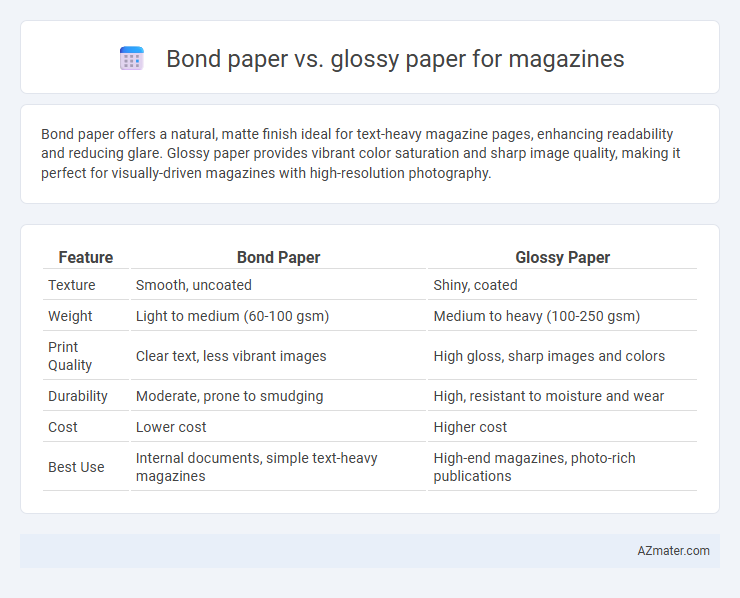Bond paper offers a natural, matte finish ideal for text-heavy magazine pages, enhancing readability and reducing glare. Glossy paper provides vibrant color saturation and sharp image quality, making it perfect for visually-driven magazines with high-resolution photography.
Table of Comparison
| Feature | Bond Paper | Glossy Paper |
|---|---|---|
| Texture | Smooth, uncoated | Shiny, coated |
| Weight | Light to medium (60-100 gsm) | Medium to heavy (100-250 gsm) |
| Print Quality | Clear text, less vibrant images | High gloss, sharp images and colors |
| Durability | Moderate, prone to smudging | High, resistant to moisture and wear |
| Cost | Lower cost | Higher cost |
| Best Use | Internal documents, simple text-heavy magazines | High-end magazines, photo-rich publications |
Introduction to Magazine Printing Paper Types
Magazine printing paper types primarily include bond paper and glossy paper, each offering distinct finishes and textures. Bond paper provides a matte, smooth surface ideal for text-heavy magazines, enhancing readability and reducing glare. Glossy paper, known for its shiny, reflective coating, delivers vibrant colors and sharp images, making it suitable for visually rich, high-impact magazine designs.
What is Bond Paper?
Bond paper is a high-quality, durable writing paper commonly used for printing documents, letterheads, and stationery, characterized by its lightweight texture and natural finish. It offers excellent ink absorption and a smooth surface, making it ideal for text-heavy content in magazines where readability is crucial. Unlike glossy paper, bond paper lacks a shiny coating, resulting in a matte appearance that reduces glare and provides a professional, understated look.
What is Glossy Paper?
Glossy paper is a highly coated, smooth, and shiny type of paper that enhances color vibrancy and sharpness, making it ideal for magazines with high-quality images and detailed graphics. This paper type uses a clay-based coating that reflects light, providing a polished finish that attracts readers' attention and improves overall visual appeal. Compared to bond paper, glossy paper offers better print quality for photos but may be less durable for frequent handling or writing.
Visual Appeal: Bond vs. Glossy
Glossy paper offers a vibrant, high-shine finish that enhances color depth and sharpness, making images and text stand out vividly in magazines. Bond paper has a matte, textured surface that provides a more subdued, professional look but can cause colors to appear less saturated and images less striking. For magazines prioritizing visual appeal and impactful imagery, glossy paper is generally the preferred choice due to its superior ability to highlight detailed graphics and rich colors.
Print Quality and Color Vibrancy
Glossy paper offers superior print quality and enhanced color vibrancy for magazines, resulting in sharp images and rich, vivid hues that attract readers. Bond paper, while more cost-effective, generally produces a matte finish with less color saturation and detail sharpness, making it less ideal for high-impact visual content. Choosing glossy paper ensures a premium appearance that elevates photographs and graphics, crucial for engaging magazine audiences.
Durability and Longevity
Bond paper offers superior durability for magazines due to its thicker, more fibrous composition, which resists tearing and creasing over time. Glossy paper, while providing vibrant colors and a polished finish, tends to be more susceptible to scratches and fingerprints, potentially reducing its longevity. For magazines intended to withstand frequent handling and extended use, bond paper ensures greater resilience and preservation of print quality.
Cost Comparison: Bond Paper vs Glossy Paper
Bond paper generally offers a more cost-effective solution for magazine printing due to its lower material and production expenses, making it suitable for large print runs on a budget. Glossy paper, while more expensive, provides a premium finish with vibrant color reproduction and enhanced image sharpness, justifying the higher cost for high-end publications. The price difference stems from the coating and brightness levels, with glossy paper requiring additional processing that significantly increases overall printing costs compared to uncoated bond paper.
Reader Experience and Handling
Bond paper offers a matte finish that reduces glare and enhances readability, making it ideal for long-form articles that prioritize comfortable reader experience. Glossy paper features a shiny surface that intensifies color vibrancy and sharpness, appealing to readers through striking visuals, but it can cause glare under bright lighting. Handling-wise, bond paper is more durable and resists fingerprints and smudges better, while glossy paper requires more careful handling to maintain its pristine appearance.
Environmental Impact and Sustainability
Bond paper generally has a lower environmental impact than glossy paper due to its simpler production process and higher recyclability. Glossy paper often contains chemical coatings and additives that make recycling more difficult and increase resource consumption. Choosing bond paper for magazines supports sustainability by reducing waste and promoting easier recycling in print production.
Choosing the Right Paper for Your Magazine
Choosing the right paper for your magazine depends on the desired visual impact and durability; bond paper offers a matte finish ideal for text-heavy, cost-effective publications, while glossy paper provides a shiny surface that enhances image vibrancy and color depth. Magazines with rich photography and vibrant graphics benefit from glossy paper's ability to attract reader attention and convey premium quality, whereas bond paper suits editorial content with a more understated, professional look. Consider the target audience, budget, and printing method to balance aesthetics and functionality when selecting between bond and glossy paper.

Infographic: Bond paper vs Glossy paper for Magazine
 azmater.com
azmater.com